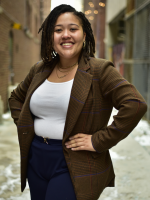How do you define “family?”
For The Filson Historical Society in Old Louisville, a recent collection defines family as more than a relationship between sons, daughters, mothers and fathers. In its ongoing exhibit “Black Homecoming,” the Filson curated nearly 200 years of photos and artifacts from nine prominent Black families and historically Black organizations throughout Kentucky to highlight different types of kinship.
The exhibit was originally supposed to highlight some of Kentucky’s Black families that contributed to state history. But the Filson’s assistant photographs and prints curator Hailey Brangers said traditional familial relationships weren't enough.
“We wanted to touch on the different communities that can make a family that aren't necessarily who you're born into,” she said. “Like how you can create a family from other things.”
A small room divided into several sections holds dozens of photos of Kentucky religious groups, neighborhoods and sports and social clubs. The exhibit's name is meant to represent how these communities come together and create their own versions of family.
“The traditional family was a little different, because we came in with one idea, but then we ended up doing a completely different idea,” said Jacqueline Hudson, the Filson’s African American history program manager. “Family reunions, unfortunately, funerals, and any type of event where Black folks come together, it's a homecoming somehow.”
The exhibit includes paraphernalia from historically-Black, Greek-letter organizations also known as the Divine 9. During the 20th Century, five fraternities and four sororities formed to support the academic success of Black college students in the United States. Today, these organizations have chapters all over the world and gain thousands of new members each year.
Hudson has been a member of Delta Sigma Theta Sorority Inc., a D9 organization founded in 1913, for seven years.
“The reason why I wanted to be in this organization is being in a group of like-minded Black women,” she said. “We're about service, scholarships [and] social action. So I think having that commonality with these women and driving the mission of the organization is what I'm passionate about.”
A picture of her sorority sisters is displayed at the exhibit alongside photos from Alpha Kappa Alpha Sorority Inc. and Alpha Phi Alpha Fraternity Inc.
As visitors journey through the collection, the photos highlight Samuel Plato, a prominent Black architect responsible for designing and constructing several post offices, banks, churches, schools and government housing projects in Louisville. Images along the back wall tell the story of Carridder Jones, a Kentucky playwright and historian who captured rural Black settlements from the 1800s, also known as hamlets.
“Hopefully people are coming and still learning about Louisville history through these families and how they helped build their communities through their work,” Brangers said.
Brangers said some families submitted centuries of family photos, including the Hammonds and the Mortons, who are descendants of spirits maker Brown-Forman’s first Black chemist Elmer Lucille Allen.
Allen, now 94, donated some of the oldest family photos and other artifacts, including some pictures that were taken in the 1870s.
For archivist Charlene Hampton Holloway, gathering family memorabilia is her life’s work. Her late grandfather, Charles D. Whitlock, opened the first Black-owned florist shop in Louisville. A photo of a young Hampton Holloway sitting with her grandfather is displayed in the exhibit.
Hampton Holloway said she broke down in tears seeing the old photo on display for the first time.
“Well, I don't want to start crying again,” she said, recounting the moment. “But I just felt so honored to see my grandfather.”
In the last 100 years, many members of the Whitlock family became prominent civil rights activists, entrepreneurs, health care professionals and political figures. In the early 1960s, a 13-year-old Hampton Holloway joined the NAACP and participated in several sit-ins and peaceful protests against Jim Crow laws.
Since then, Hampton Holloway, now 78, has been collecting her family’s history and uncovering their impacts on Kentucky. She wrote a book about her family’s legacy, and she donated many of her discoveries to the Filson for the exhibit.

“Any time you can donate something that's of great history and value, it's just hard to describe the pleasure and the fulfillment of my life and legacy to be a philanthropist,” she said.
“Black Homecoming” will be open through February. The exhibit is part of the 2025 Louisville Photo Biennial, a project that uplifts art and photography from Louisville, Southern Indiana and central Kentucky.
Editor’s note: The Filson Historical Society provides support to Louisville Public Media.






